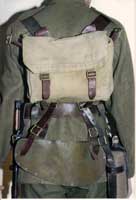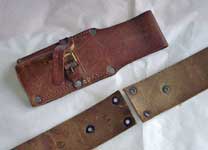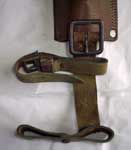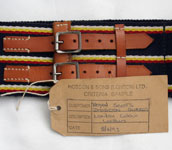Infantry Equipment, Pattern 1914 - Colour
Service Dress and London Brown - What do those terms mean, exactly?
 Infantry Equipment, Pattern 1914 was introduced by L. of C. 16977, with an acceptance date of 30th August, 1914. In the second paragraph, that L. of C. states that "equipment, except the pack and haversack, is made of pliable hide leather, stained as near as possible to the colour of the service dress." A few months later, L. of C. 17219, was introduced, with acceptance dates of 31st December, 1914, and 30th March, 1915, amends this:
Infantry Equipment, Pattern 1914 was introduced by L. of C. 16977, with an acceptance date of 30th August, 1914. In the second paragraph, that L. of C. states that "equipment, except the pack and haversack, is made of pliable hide leather, stained as near as possible to the colour of the service dress." A few months later, L. of C. 17219, was introduced, with acceptance dates of 31st December, 1914, and 30th March, 1915, amends this:
2. The colour of the leather portion of the "Infantry Equipment, Pattern 1914" will, in future manufacture, be "London brown" instead of "service dress" colour.
The question today's reader asks, of course, it just what did the War Office mean by "service dress" and "London brown"? It was terribly thoughtless of them not to have included a colour chart, but in the absence of this kind of primary source, we can only fall back on examination of surviving items of the equipment.
What we find when we do this, though, is that items of Pattern 1914 equipment can be founds in a myriad of colours, ranging from reddish tan through true browns, some pieces having distinctly greenish overtones, whilst others are so dark as to be nearly black. In the first version of Karkee Web's section on Infantry Equipment, Pattern 1914, we interpreted "service dress" as a light brown, and "London brown" as a darker shade. Not everyone was in full agreement, to be honest, but that was the consensus at the time. Since then, we've changed our opinion. We now feel that all of the "London brown" items were made in a more-or-less light brown, and that the darker shades are the result of time, wear, oil, and dirt. There were many manufacturers of Patt. '14, of course, and that almost certainly meant plenty of variations in original colour, but they could all be fairly described as light brown.
So what, then was "service dress"? Firstly, it was only made for a short time, August to December 1914, more-or-less, so it isn't all that common, and quite a bit of it must have ended up in the mud of Flanders. KW hasn't seen many items of Patt. '14 actually dated 1914. We have noted, though, that some, but not all, of the demonstrably early pieces show a distinctly greenish hue - not a true green, but a greeny-browny sort of colour that is a very close match to the "khaki" colour of the British service uniforms of the period. This is splendidly illustrated in the John Bodsworth photograph (© John Bodsworth 2011) above left. Note the almost perfect match between the Intrenching tool carrier and the tunic. This, we believe, is what the War Department intended when the used the phrase "stained as near as possible to the colour of the service dress."

 The two photos at left show "service dress" pieces together with "London brown" ones. Far left, a London brown Frog is shown above a service dress Brace, which has been converted for use as a strap on an officer's Haversack. Near left, the London brown Frog is shown with an American made service dress Helve carrier. From the Steve Hewitt Collection, photos © Steve Hewitt 2011.
The two photos at left show "service dress" pieces together with "London brown" ones. Far left, a London brown Frog is shown above a service dress Brace, which has been converted for use as a strap on an officer's Haversack. Near left, the London brown Frog is shown with an American made service dress Helve carrier. From the Steve Hewitt Collection, photos © Steve Hewitt 2011.
These photos also illustrate a major pitfall of using on-line photographs to judge colour. On a plain white background like this, it's impossible to judge the fidelity of the colour reproduction. Adding to this, every monitor will reproduce colour slightly differently, and finally, it would be almost trivial to use software to manipulate the hue. Those sorts of factors are what make John Bodsworth's photo above so valuable - there is a clear colour comparison within the picture itself.
A final photograph at right. This one, from the John Bodsworth Collection (© John Bodsworth 2012), shows a modern (1993) example of London Brown leather. Of course, this is not to say that all London Brown items of WWI vintage actually started out in exactly this shade - there must have been quite a bit of variation then, just as there was during WWII with Pattern 1939. We do believe, though, that the colour shown here is likely to be quite similar to what the War Office had in mind when they specified "London Brown". In fact, if you look at the London Brown Frog shown above left, it is easy to believe that it was just this colour when it was made, eighty-odd years ago.
